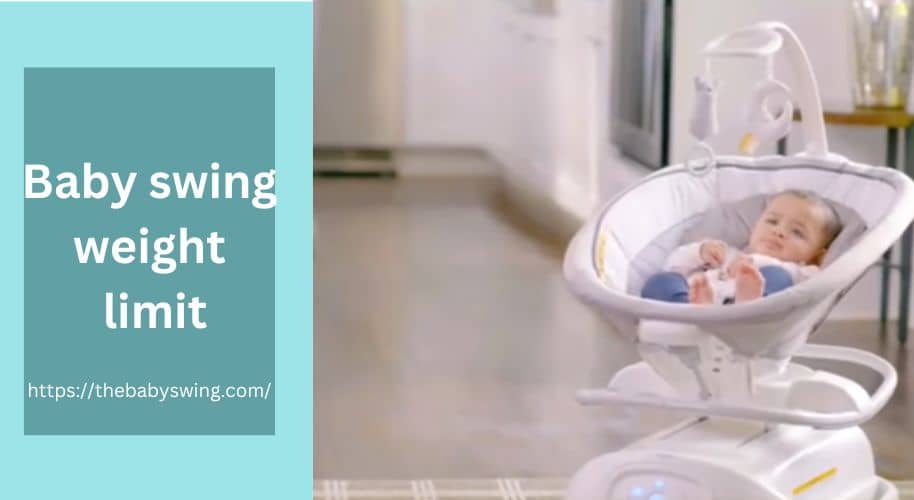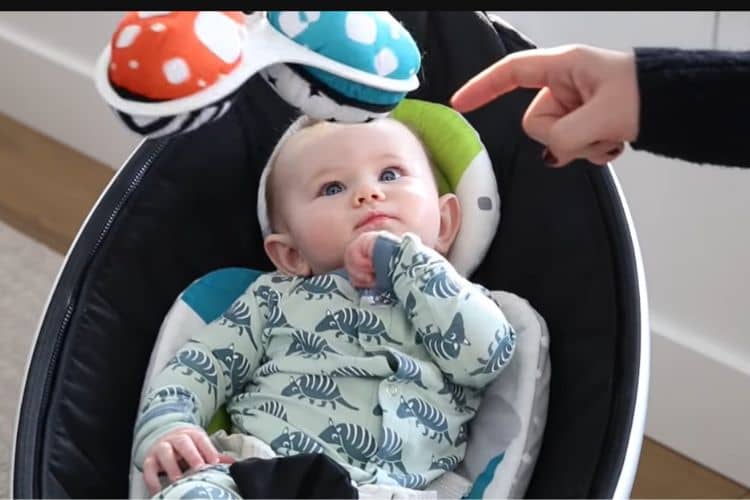Last Updated on October 30, 2023
When it comes to using a baby swing, safety is of utmost importance. Knowing the weight limit of your baby swing is essential to ensure that your little one is safe and secure while they enjoy their time in the swing.
The recommended weight limit for most baby swings is 25-30 pounds. However, some swings have a lower weight capacity of 20 pounds, while others can hold up to 35 pounds.
It’s important to check the manufacturer’s guidelines before usage and make sure you are aware of the maximum weight limit for your specific baby swing.
In this blog post, we’ll explore various baby swing weight limit and age limit information and provide helpful tips to ensure your baby’s safety while they’re swinging. We’ll also discuss what you should look for in a quality baby swing and how to find the right one for your little one.
Let’s get started!

Baby swing weight limit and age limit
Here, we’ve listed the most popular baby swing’s weight and age limit.
| Swing | Weight Capacity | Age Limit |
| Graco Soothe ‘n Sway LX Baby Swing | 5.5 to 30 pounds | 9 months |
| Ingenuity Soothe ‘n Delight | 6 to 20 pounds | 0-9 months |
| Nova Baby Swing | Up to 20 pounds | 0-6 months |
| Maxi-Cosi Cassia Swing | Up to 20 pounds | 0-6 months |
| Graco Simple Sway | 30 Pounds | Less than 24 months |
| 4moms MamaRoo | 25 Pounds | Newborn & Up |
| Munchkin Bluetooth Enabled Lightweight | 20 pounds | 0-6 months |
| Ity by Ingenuity Swingity Swing | 20 Pounds | birth to 9 months |
| Ingenuity Anyway Sway | 20 Pounds | birth to 9 months |
| Graco Sense2Soothe Baby Swing | 25 Pounds | 9 months |
How much weight can a baby swing hold?
We’ve already mentioned above that the maximum weight capacity of a baby swing depends on the type of swing and the manufacturer’s guidelines.
That’s why you need to read the instructions before using a baby swing, as some may have a lower maximum weight capacity. However, most baby swing’s weight limit is usually 25 to 30 pounds.
Newborn babies can use swings safely, and they can typically be used until the specified weight or age limit.
When to start using baby swings?

When it comes to using baby swings, the American Academy of Pediatrics recommends waiting until your baby is at least 4 months old.
At this age, your baby should have good head control and be able to sit up on their own.
You also must ensure the swing frame won’t collapse or fold easily and that your baby is in the most reclined position.
However, some parents start using swings right after their baby’s birth, and some may wait until the first few months.
According to the American Academy of Pediatricians, regardless of when babies start using a swing, it should always be supervised, and the seat position should stay in its most reclined setting for any child below four months old.
Also read: How long can a baby stay in a swing chair
When should baby stop using swing?
Generally, babies can use swings until they are about 9 months old or reach 20 pounds. Additionally, you should also stop using a baby swing once your infant shows signs they want to crawl out (usually around 9 months).
Once your little one is ready to crawl out, it’s time to move on from the swing. If you are concerned about your baby trying to escape, discontinue using their swing and focus on other options for safe play.
This can include playing in a playpen, supervised tummy time on the floor, or other activities that involve exploration and movement. These are all great opportunities to help your baby reach their developmental milestones while having fun at the same time.
You also need to check the swing before each use to ensure all the parts are in working order and there aren’t any broken parts that could pose a choking hazard. If you notice anything out of place, discontinue use right away.
“Baby swings are not a substitute for direct supervision and should never be used as a babysitting tool,” says Todd Ochs, a Pediatrician at Ravenswood Pediatrics.
“Babies should always be supervised when in their swing. As always, it’s best to discuss any questions you have with your pediatrician before using the swing or beginning any new activity with your little one,” added Todd.
Also read: Can babies sleep in mamaroo swing
Is baby swing harmful?
Baby swings are generally safe for babies, as long as they are used correctly and within the manufacturer’s guidelines. However, it is important to be aware of potential safety hazards that can arise when using a baby swing.
The American Academy of Pediatrics recommends that babies should not sleep in a baby swing, as this can increase the risk of Sudden Infant Death Syndrome (SIDS).
Additionally, you also need to ensure that the baby swing is securely fastened and never left unattended while in use. You also must check the weight limit of the baby swing and make sure that your child does not exceed it.
On the other hand, when your little one falls asleep in a semi-upright position while using baby swings or other seating devices, they’re at risk of their head falling forward to their chin and becoming asphyxiated. It’s important to take extra precautions when using such products.
Dr. Todd emphasizes using the most reclined position of the swing as this greatly reduces the risk of SIDS. Additionally, he also suggests using a baby swing and other seating products only when the baby is awake and properly monitored.
You should limit the use of a baby swing to 20 minutes at a time, and discontinue use once your baby can sit up on their own. You also keep the straps snugly fastened around the baby’s body at all times.
In addition, be sure to regularly check for any recalls or warnings about the product you plan to use.
For example, 4moms has issued a recall of over 2 million MamaRoo and RockaRoo infant swings and rockers due to the potential risks of entanglement or strangulation.
Dr. Todd also recommends avoiding swings or bouncers with an inclined seat, as this can put babies in an unsafe position.
Also Read: When baby outgrows swing
The American Academy Of Pediatrics (AAP) Safe Swing Use Guidelines
Using a baby swing can be a great way to soothe your little one, but you must use it safely. Here are the AAP guidelines for using a baby swing safely:
- Always use the swing as intended by the manufacturer. Read the instruction manual and check for any recalls before using the swing.
- Know the weight limits of the swing and make sure your baby does not exceed them.
- Make sure newborns are reclined as far back as possible in their swings to avoid slumping over and suffocating.
- Never put anything else in the swing with your baby, such as toys or blankets, which could lead to suffocation or strangulation hazards.
- Supervise babies while they are in their swings, especially if they fall asleep while using it.
- Do not feed babies in swings or bouncers since this can increase their risk of choking or aspiration pneumonia from inhaling food particles into their lungs.
- Check that all straps, buckles and other parts of the swing are secure before putting your baby in it each time you use it, and make sure there is no damage that could cause injury to your child while in the swing.
- Limit your baby’s time in a swing to 30 minutes at a time, and never leave them unattended for long periods of time while they’re in it.
- When your baby has outgrown their infant seat or reaches 4 months old (whichever comes first), transition them out of the swing and into an appropriate sleeping space such as a crib or bassinet instead of continuing to use it for sleep purposes due to safety concerns associated with leaving babies unattended in swings for extended periods of time overnight or during naps throughout the day.
Are swings safe for babies with special needs?
Yes, swings can be safe for babies with special needs as long as they are properly used and monitored. Special considerations should be taken when using a swing for a baby with special needs such as making sure the swing is placed on a level surface and using straps or other restraints to ensure that the baby does not slip out of the seat.
Additionally, you also need to closely monitor the baby while in the swing to ensure that they are not getting too hot or uncomfortable.
Babies with special needs may require extra time to adjust to using a swing, so patience and care should be taken when introducing the swing to them.
Wrapping Up
Thanks for reading this guide on baby swings and their weight and age limit. Whenever you’re in the market for a baby swing, make sure you consider the safety of your little one first by checking its weight limit before purchasing.
Please share this information with family and friends so everyone can stay informed on baby swing safety.
If you have any further questions or concerns, please do not hesitate to reach out to us. We’re always here to help!
Sources:
- https://www.forbes.com/sites/forbes-personal-shopper/article/best-baby-swings/
- https://www.nytimes.com/wirecutter/reviews/best-baby-swings/
- https://www.healthline.com/health/baby/sleeping-in-baby-swing#:~:text=The%20American%20Academy%20of%20Pediatrics,for%20a%20crib%20or%20bassinet
Sharing Is Caring!

Amy A. Vincent is a Certified Pediatric Sleep Consultant and a mother of three beautiful children. She helps parents transition their babies from swing sleep to safe, independent sleep. She is passionate about helping parents teach their children the skills needed to become good sleepers and aims to make the process as easy and stress-free as possible. Read more
